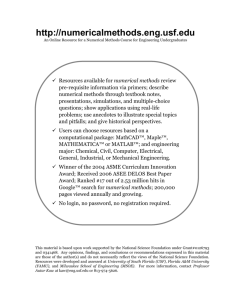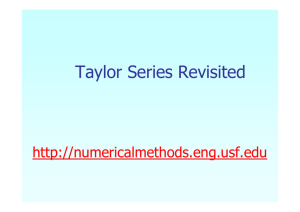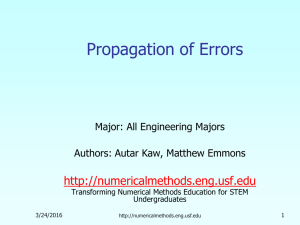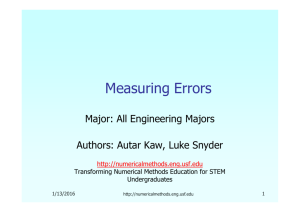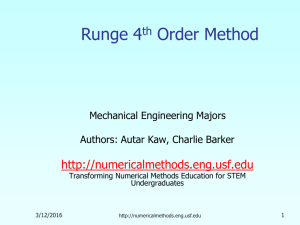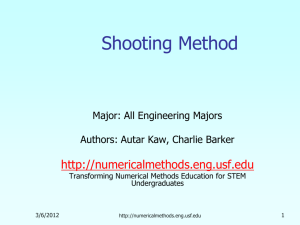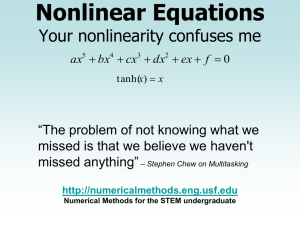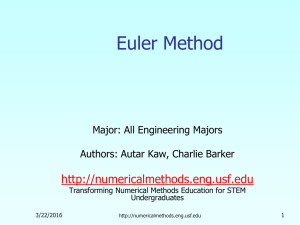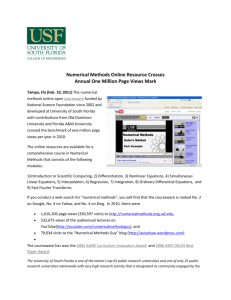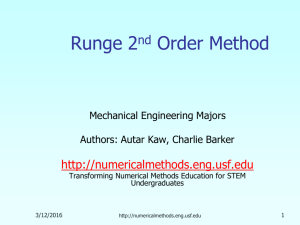Taylor Series Revisited
advertisement
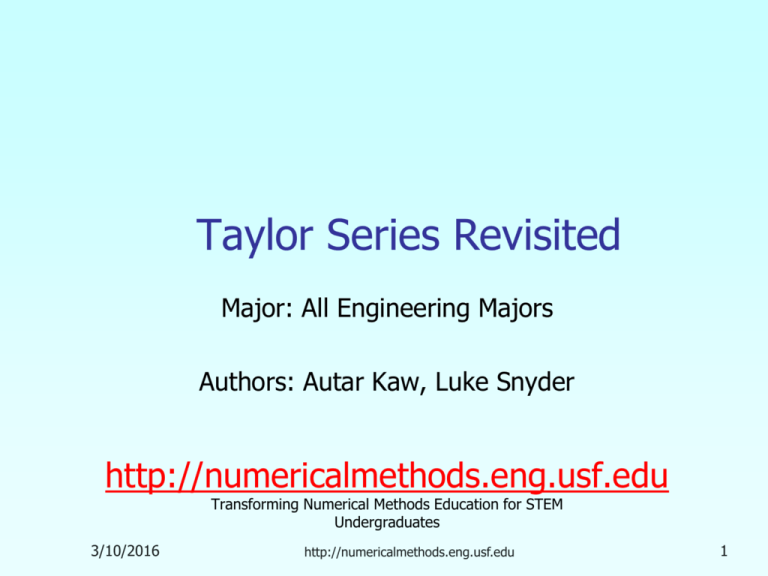
Taylor Series Revisited Major: All Engineering Majors Authors: Autar Kaw, Luke Snyder http://numericalmethods.eng.usf.edu Transforming Numerical Methods Education for STEM Undergraduates 3/10/2016 http://numericalmethods.eng.usf.edu 1 Taylor Series Revisited http://numericalmethods.eng.usf.edu What is a Taylor series? Some examples of Taylor series which you must have seen x2 x4 x6 cos( x) 1 2! 4! 6! x3 x5 x7 sin( x) x 3! 5! 7! x2 x3 e 1 x 2! 3! x 3 http://numericalmethods.eng.usf.edu General Taylor Series The general form of the Taylor series is given by f x 2 f x 3 f x h f x f x h h h 2! 3! provided that all derivatives of f(x) are continuous and exist in the interval [x,x+h] What does this mean in plain English? As Archimedes would have said, “Give me the value of the function at a single point, and the value of all (first, second, and so on) its derivatives at that single point, and I can give you the value of the function at any other point” (fine print excluded) 4 http://numericalmethods.eng.usf.edu Example—Taylor Series Find the value of f 6 given that f 4 125, f 4 74, f 4 30, f 4 6 and all other higher order derivatives of f x at x 4 are zero. Solution: h2 h3 f x h f x f x h f x f x 2! 3! x4 h 64 2 5 http://numericalmethods.eng.usf.edu Example (cont.) Solution: (cont.) Since the higher order derivatives are zero, 22 23 f 4 2 f 4 f 42 f 4 f 4 2! 3! 2 2 23 f 6 125 742 30 6 2! 3! 125 148 60 8 341 Note that to find f 6 exactly, we only need the value of the function and all its derivatives at some other point, in this case x 4 6 http://numericalmethods.eng.usf.edu Derivation for Maclaurin Series for ex Derive the Maclaurin series x2 x3 e 1 x 2! 3! x The Maclaurin series is simply the Taylor series about the point x=0 h2 h3 h4 h5 f x h f x f x h f x f x f x f x 2! 3! 4 5 h2 h3 h4 h5 f 0 h f 0 f 0h f 0 f 0 f 0 f 0 2! 3! 4 5 7 http://numericalmethods.eng.usf.edu Derivation (cont.) Since f ( x) e x , f ( x) e x , f ( x) e x , ... , f n ( x) e x and f n (0) e0 1 the Maclaurin series is then (e 0 ) 2 ( e 0 ) 3 f ( h ) (e ) (e ) h h h ... 2! 3! 1 1 1 h h 2 h 3 ... 2! 3! 0 0 So, x 2 x3 f ( x) 1 x ... 2! 3! 8 http://numericalmethods.eng.usf.edu Error in Taylor Series The Taylor polynomial of order n of a function f(x) with (n+1) continuous derivatives in the domain [x,x+h] is given by h2 hn n f x h f x f x h f ' ' x f x Rn x 2! n! where the remainder is given by n 1 x h n 1 Rn x (n 1)! f c where x c xh that is, c is some point in the domain [x,x+h] 9 http://numericalmethods.eng.usf.edu Example—error in Taylor series x The Taylor series for e at point x 0 is given by x 2 x3 x 4 x5 e 1 x 2! 3! 4! 5! x It can be seen that as the number of terms used increases, the error bound decreases and hence a better estimate of the function can be found. How many terms would it require to get an approximation of e1 within a magnitude of true error of less than 10-6. 10 http://numericalmethods.eng.usf.edu Example—(cont.) Solution: Using n 1 terms of Taylor series gives error bound of n 1 x h x 0, h 1, f ( x) e x Rn x f n 1 c n 1! n 1 0 1 Rn 0 f n 1 c n 1! n 1 1 ec n 1! Since x c xh 0 c 0 1 0 c 1 11 1 e Rn 0 (n 1)! (n 1)! http://numericalmethods.eng.usf.edu Example—(cont.) Solution: (cont.) So if we want to find out how many terms it would 1 require to get an approximation of e within a magnitude of true error of less than 10 6 , e 10 6 (n 1)! (n 1)! 106 e (n 1)! 106 3 n9 So 9 terms or more are needed to get a true error less than 10 6 12 http://numericalmethods.eng.usf.edu Additional Resources For all resources on this topic such as digital audiovisual lectures, primers, textbook chapters, multiple-choice tests, worksheets in MATLAB, MATHEMATICA, MathCad and MAPLE, blogs, related physical problems, please visit http://numericalmethods.eng.usf.edu/topics/taylor_seri es.html THE END http://numericalmethods.eng.usf.edu

